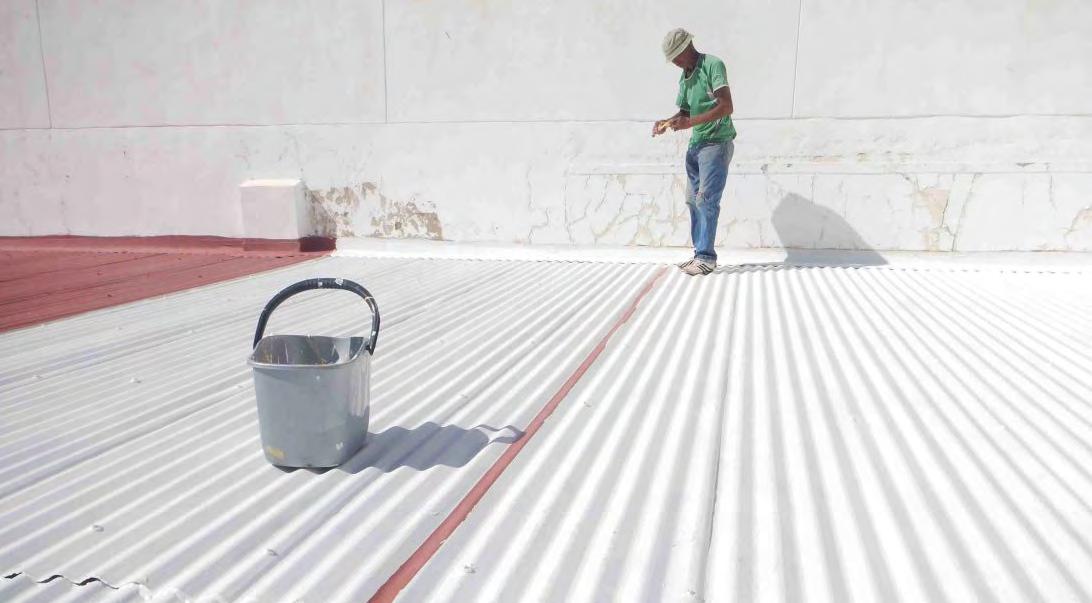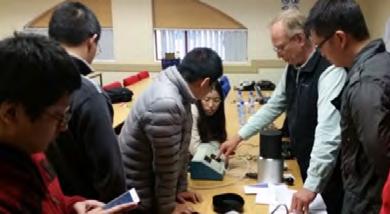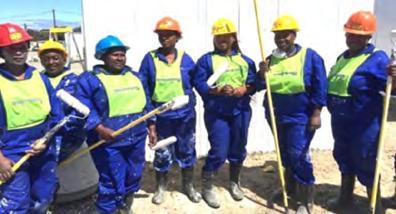
3 minute read
COOL SURFACES SAVE ENERGY – and improve quality of life
During the past 12 months, a SANEDI study has proven that nano-technology in paint can make life much better in even the humblest dwellings, while helping South Africa achieve its energy-saving goals.
If ever there was an energy-saving programme that ordinary South Africans can get behind, it’s the Cool Surfaces Project that started as an initiative of the Clean Energy Ministerial, under the auspices of the USA Department of Energy. In 2013, the then South African Department of Energy (represented by SANEDI) joined the Global Superior Energy Programme (together with India, Japan, Korea, Mexico and the USA) to create the Cool Roofs and Pavements Working Group. SANEDI partnered with the Global Cool Cities Alliance (GCCA) who provided technical support to establish the Cool Surfaces Programme in South Africa.
Advertisement
The Cool Surfaces Project is a response to South Africa’s need for an energy-passive, low-cost and low-maintenance cooling technology for buildings. In very simple terms, it means painting walls and roofs with coatings that keep buildings cool inside so that the people living and working in them need less – or even no – air conditioning to be comfortable.

Given how hot South African summers can be, cooling and air conditioning are major consumers of electricity and, as a consequence, major contributors to greenhouse gas emissions.
PROJECT ADVANCES IN THE 2022/23 FINANCIAL YEAR
The Cool Surfaces Project kept SANEDI busy in the past financial year. In order to enable a sustainable passive-energy cool-coating market, we looked at the entire industry value chain to identify key drivers, challenges and opportunities.
Based on this holistic perspective, we drafted the Cool Surfaces Roadmap that sets out nine deliverables:
1. Select available products from the global market.
2. Adopt and publish South African national standards for product performance testing.
3. Pilot projects for proof-of-concept efficacy.
4. Run demonstration and large-scale projects.
5. Collect and analyse data to make recommendations for improvement.
6. Establish skills training and education.
7. Establish an industry association to participate in building materials regulation.
8. Do energy-efficiency building benchmarking and simulation modelling.
9. Establish a SANEDI cool surfaces lab within a building envelope for product performance testing.
In addition to charting a way forward, SANEDI addressed three challenges that could potentially hamper the implementation of cool-surfaces technology.
Cool surfaces during winter
CHALLENGE: SANEDI research indicates that cool reflective surfaces products are excellent at cooling the interior of buildings in summer but do not assist with heat retention in winter. This is of particular relevance in low-income communities where the buildings are poorly constructed with insufficient protection against heat loss. Although excessive heat is an issue for most of the year, extreme cold causes more deaths as South Africans are less prepared for and, therefore, less resilient against cold.

REMEDIATION: SANEDI piloted a project using thermal insulation to passively warm the interiors of buildings to counter poor design and materials.

Artificial competition between cool reflective surfaces and thermal insulation
CHALLENGE: The established and trusted insulation industry became concerned that nano-technology cool coatings would compete with thermal-control materials for market share in the built environment. The sense of competition was exacerbated when it was suggested that the building code should accommodate cool reflective surfaces by reducing the minimum thickness requirements for thermal insulation. SANEDI protested that this offset measure was ill advised.
REMEDIATION: SANEDI collaborated with TIPSASA in a joint experiment to prove its claim that insulation and cool surfaces would work better together. The project was implemented in Masonwabe informal settlement in Gugulethu in the Western Cape.

SANEDI cool-coated 14 000 square metres of walls and roofs of dwellings built with wooden frames and corrugated sheet metal. TIPSASA member companies, Eco-Insulation and IsoBoard, sponsored the insulation of 16 houses. The number of manufacturers that could participate was limited by the lack of ceilings in the houses. Three types of reference houses were set aside, namely, houses with neither cool coating nor insulation, houses with only cool reflective coating, and houses with both insulation and cool reflective coating. Measuring equipment was installed with dataloggers, manual collection of data was done every three months (one last set of data collection remains), and anecdotal evidence was collected via surveys.
The preliminary findings are confirming and exceeding our expectations. As expected, the evidence shows that insulation is best at heating buildings and cool reflective coatings are best at cooling them. Together, the two technologies regulate thermal comfort more effectively than either on its own. While the cost of heating an insulated building in winter remains the same whether or not it has a cool roof, it is three to nine times more expensive to use insulation for cooling than it is to apply a cool reflective coating. In fact, the energy savings from the triple insulation thickness needed for cooling will take 17 years to offset the investment. By using the two technologies together, energy savings are doubled as energy demand is reduced throughout the year. Finally, not only does poor ventilation (sealed and too few windows) not reduce heat loss in winter, but it adds to heat gain in summer.
Extrapolated from the current sample size, the potential impact on a 26m2 sized home with an average occupancy of four people are as follows, bearing in mind that very few informal-settlement residents use heating and cooling electrical appliances:

• Winter savings per household: 55.8kW/h = 9.3kW/h per month (R122,76 saved).
• Summer savings per household: 31.8kW/h = 5.3kW/h per month (R69,96 saved).
• Winter ambient temperature: average = 120C, but inside uninsulated house as low as 30C.
• Summer ambient temperature: average = 34.50C, but inside uncoated house as high as 41.10C.
*GHG emissions to be calculated by end of June 2023.










